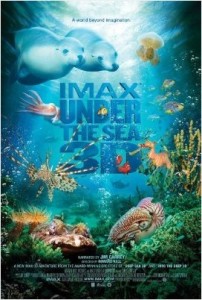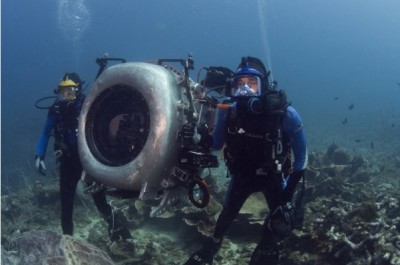By: debbie lynn elias
 For many of us, our first exposure to “nature” films and the wonders of the beautiful planet Earth, was compliments of Walt Disney. We traveled to the wild jungle, the openness of the African Plains and saw the beauty of melting snows and crystal clear rivers and rills, and the ecocosm of a place called Beaver Valley. And it was Jacques Cousteau who enthralled us with the wonders of the deep blue sea and the very world that existed below its glassy surface. As technology advanced, James Cameron even got into the act with some stunning undersea filmmaking. But no one holds a candle to veteran award-winning IMAX filmmaker, Howard Hall. A skilled cinematographer and director , Hall has not only brought us some of the most exquisite imagery from the sea with 1994’s “Into the Deep”, “Deep Sea”, “Island of the Sharks” and “Coral Reef Adventure”, but is a gifted storyteller, allowing Mother Nature to speak for herself. Now, Hall delights and fascinates us with his latest underwater documentary adventure – and one of his finest works – UNDER THE SEA 3D.
For many of us, our first exposure to “nature” films and the wonders of the beautiful planet Earth, was compliments of Walt Disney. We traveled to the wild jungle, the openness of the African Plains and saw the beauty of melting snows and crystal clear rivers and rills, and the ecocosm of a place called Beaver Valley. And it was Jacques Cousteau who enthralled us with the wonders of the deep blue sea and the very world that existed below its glassy surface. As technology advanced, James Cameron even got into the act with some stunning undersea filmmaking. But no one holds a candle to veteran award-winning IMAX filmmaker, Howard Hall. A skilled cinematographer and director , Hall has not only brought us some of the most exquisite imagery from the sea with 1994’s “Into the Deep”, “Deep Sea”, “Island of the Sharks” and “Coral Reef Adventure”, but is a gifted storyteller, allowing Mother Nature to speak for herself. Now, Hall delights and fascinates us with his latest underwater documentary adventure – and one of his finest works – UNDER THE SEA 3D.
Situating himself in the Indio-Pacific rim and the famed Coral Triangle, the Great Barrier Reef and Papua New Guines, Howard Hall welcomes us into these exotic undersea worlds; worlds that are really being seen by us for the first time. According to co-producer Michele Hall, (also a master diver and wildlife photographer), “The Coral triangle is truly the center of biodiversity and a very significant area rich with ocean life.” This region is home to 40% of the world’s reef wildlife population with more than 75% of documented coral species and over 3,000 species of fish, crustaceans, sea turtles, marine mammals and mollusks. Filming entirely with IMAX 3D cameras, this is perhaps the most ambitious IMAX 3D production ever undertaken, but despite the daunting task and the perils faced in a project of this nature, Hall’s visuals are of crystaline clarity and beauty, drawing you – the viewer – ever deeper under the sea.
From the opening frame, you are transported to a world that exists thanks to a very delicately balanced ecosystem, a world that is being threatened by global warming, a world where treachery and danger lurk behind every rock or under every grain of sand, yet, a world where Crown Jellyfish move with the grace of a tulled ballerina dancing to “Swan Lake” and Cuttlefish use their own dance to court a shy mate, where Leafy and Weedy Sea Dragons look as mystical and magical as something from the world of Harry Potter and Giant Sea Eels rise from the sand 6 feet high creating their own “garden” that looks like branches wafting in the wind or wheat waving playfully against a setting sun on an open plain, and where Australian Sea Lions play, melting your heart with each look into the camera. Thanks to the IMAX 3D technology, the level of quality at work here makes it seems as if you are underwater with Hall’s camera – that your face mask is in place and you are the one holding the camera. As you turn your head, the imagery retains its natural focal depth, clarity and eye-popping color and texture, causing you to actually reach out your hand to try and touch a silvery fin or some roughly hewn coral. The effect is nothing short of ethereal.
Moving from one site to another, Hall only intensifies our love affair with the deep and its inhabitants, and thanks to careful editing, allows us to linger over the wonders of a Winderpus Octopus, Blue-Spotted Stingrays, Crocodile Fish (which are too cool for words) and even one of my faves, Epaulette Sharks who use their fins to walk on the ocean floor. Not using quick frame edits, Hall insures that we establish relationships and connect with the creatures, see their personalities (yes, even little fish have personalities) emerge and embrace them as we would a new friend. But for all the magic and wonder, UNDER THE SEA 3D shows the practical side of symbiotic existence in ecosystems which means, you will see some cute little creatures getting chomped on as an appetizer or main course for someone else’s dinner. And as easily as one life ends, others begin, often in very interesting manners, all of which is captured by Hall’s cameras. Thus, is the cycle and circle of life.

Narrated by Jim Carrey, the film is an educational delight. Filled with information on each area visited and the various species indigenous to each, Carrey would have never entered my mind as a narrator for this project. However, let me tell you – he is incredible. With perfectly nuanced tones, he compliments the visuals to a tee. Making this undersea haven attainable to young and old alike, in one moment he captures the humor of this watery world with a tempered and well inflected joke similar to that he would make about something in “our” world, and in the next moment, we hear his sadness and somberness as scenes shift and once vibrant colorful worlds take on a deathly grey pallor void of beauty and color, and Carrey talks about the destruction and death of this beautiful world thanks to man’s abuse of the world above and global warming. Not only is the script passionate, but it is as artfully crafted as nature herself crafted this undersea pantheon of delights. And Carrey just draws you deeper into its magical spell. 
By now, you are probably wondering what makes this IMAX 3D technology so critical to the excellence of this film. So, how about a little primer, considering IMAX 3D is the wave of the future and an ever present force in film today. Developed by Graeme Ferguson (one of the producers of UNDER THE SEA 3D), Roman Kroitor, Nicholas Mulders and Williams C. Shaw, IMAX is short for Image MAXimum. Ths system is able to display images that are much larger and of much greater resolution than that of regular film by using a larger film frame that allows for resolution equivalent to 70 megapixels (10,000 x. 7000 pixels). While filming, 70mm film is run horizontally through the cameras. And due to the size, in order to expose the film at standard film speed of 24 frames per second, three times as much film is required when shooting in IMAX. Also enhancing the visual experience is the fact that IMAX film doesn’t embed soundtracks but instead uses a separate 6 channel 35mm magnetic film that is synced to the IMAX film. In order to create the 3D effect, two camera lenses are used which represent the human eyes (a right and a left, last time I checked). The lenses are then separated by 2 ½ inches, which is roughly the distance between your eyeballs on your face. Filming two separate rolls of film (one for the right and one for the left) and then melding and projecting concurrently, the viewer is transported into the world of 3D.

Technically, making an IMAX 3D film presents an entirely new set of challenges not faced in normal filming. For UNDER THE SEA 3D, one camera alone – including its waterproof housing for undersea photography – weighs over 1,300 pounds. The full equipment compliment for the shoot weighed over 8,000 pounds. All of this equipment had to be transported, carried, assembled and broken down on a daily basis, in this case, 110 days at sea. And in that 110 days, 350 hours were spent underwater just to capture ten (10) hours of raw footage, which now translates into 40 minutes on the big screen. However, separate and apart from the logistics and equipment, according to Hall, one of his biggest challenges under the sea was “to be ready for anything. Sometimes you get a lucky shot. But you can’t get lucky unless you are down there trying.” And while there were, of course, disappointing dives, those hours spent pale when compared to the dazzling beauty and intensity of the end result. And as if it was ever even needed, music by Micky Erbe and Maribeth Solomon only adds to the passion, play and magic of the experience.
What you will see is exactly what Howard Hall saw and experienced, but without the cold and wet of actually diving. You will feel the excitement and adrenalin rush of a relatively new species swimming into view or a Crocodile Fish springing up from nowhere and appearing to land right in your lap or the leathery sheen of a Great White passing right over your head as you gaze up in awe. But beyond the beauty and excitement, you will gain a new or renewed appreciation for our planet and particularly this very precious world under the sea.
UNDER THE SEA 3D – the only film you will ever see that you never want to have end.
Narrated by Jim Carrey. Written and directed by Howard Hall.











